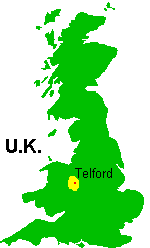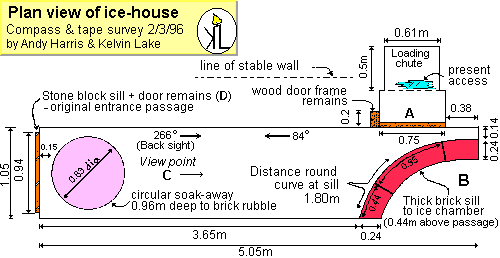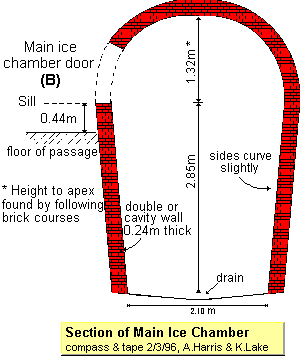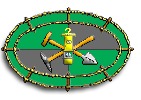 During drainage and sewerage improvements on a local
estate a few miles west of Shrewsbury, one of the workmen, while trenching
along side an old cast iron pipe had the ground open up under him revealing
a large cavity! Using a small drilling rig they hit something hard near
this hole a few inches down, while making another attempt to drill a few
metres away the rig hit another cavity and the drill rods were lost.
During drainage and sewerage improvements on a local
estate a few miles west of Shrewsbury, one of the workmen, while trenching
along side an old cast iron pipe had the ground open up under him revealing
a large cavity! Using a small drilling rig they hit something hard near
this hole a few inches down, while making another attempt to drill a few
metres away the rig hit another cavity and the drill rods were lost.
A small team of Club members (equipped with the MineCam) visited the site by the stable block on the estate.
Situated part the way up a small valley, several metres above the level of the River Severn it seemed unlikely to be a canal tunnel - a cess pit or large night soil chamber sprang to mind (I have been caught before by 'caves' near to Kents cavern in Torquay, which on 'closer' examination were brick vaulted night-soil chambers!).
The hole was re-excavated (it had been covered for safety), to reveal
a tantalising cavity that lead to something big, but not big enough to
get a head down or the MineCam. After a bit of careful chiselling of the brick
work around the cast iron sewage pipe we were able to lower the MineCam
into the cavity.
 The MineCam Descent
The MineCam Descent
The camera passed down a short angled chute to reveal a passageway running East-West. On the South side of the passage was a curved doorway (B) of what was the nicest ice-chamber you could ever hope to see, all in remarkable condition!
That was it, chisel flying, we enlarged the hole to body size and managed to squeeze inside. The drill rods from the rig had actually just glanced down the side of the passage wall, a few millimetres further South and they would never have hit it.
The original entrance to the ice-house had obviously had a stout wooden door (D) at the bottom of some steps. The steps and way down had been filled with rubble and stone while the door was closed. This had subsequently rotted away, leaving a few traces near the bottom and the rubble stacked behind. Immediately in front of the door was a circular drainage/soak-away pit. This had once been covered by brick flooring, but it has now collapsed into the pit.
The current hole to surface (A) actually enters what was probably the loading chute for the ice-house, this is under the present stable block, but they were extended some years ago, probably at the time the ice-house was 'buried'.
Where the ice for this ice-house came from can only be conjecture, there is no mention of the building on any surviving estate plans. It is in a typical position for such a building - on the side of a well drained valley (to allow both surface water and internal melt water to drain away) and near the stable block, where carts could easily be brought when loading the ice-house.
Some estates had ponds especially for collecting ice in the winter, but the majority had the ice delivered - often from Canada! The ice would be transferred from the ice-house to special lead encased 'cool-boxes' in the main house immediately prior to use. The Estate owner remembers seeing such a box in the cellar of the old house, when one of his Aunts still lived there (the house has since been demolished).
 The Ice Chamber
The Ice Chamber
This was fairly small but again a typical 'flask' shaped chamber with
domed roof - it was presumably the bricks in the top of the chamber that
the drilling rig was unable to penetrate (luckily!). At regular intervals
around the walls of the chamber were tiny drain holes, to allow any melted
water to run off - it is very important to keep the ice dry, otherwise
it does not last.
A nice feature around the walls of the chamber, level with the sill of the entrance door, were soot marks from candles, plus a few signs of hooks, where meats etc.. could have been hung, although it was common practice to put the meats in straw actually on top of the ice. The top section of the chamber (above the doorway) still showed signs of white-wash, while the main part of the chamber was plain, red brick. In the base of the chamber was a central drain, with the remnants of a wood frame and iron grill.
The doorway (B) into the chamber had a very thick wood frame, as did the remains of the doorway at the bottom of the loading chute (A).
A superb discovery, which we managed to measure, video and photograph. We also managed to get the Estate owner down into the chamber so he could see it first hand.
Since the Ice-house was discovered, the development at the site has been
completed and the Ice-house retained as a feature with the entrance steps
and doorway reconstructed to allow visitors into the building on special open days.
Credits: Thanks to: Brian Lewis (Lewis Howdell Associates) for inviting us along to investigate such an interesting site and the Hon. C.G.O.Bridgeman for allowing us access to the estate and for providing us with large quantities of toasted cheese sandwiches and tea afterwards. Report: Kelvin Lake Survey: Andy Harris and Kelvin Lake |
Warning
|
